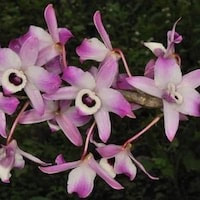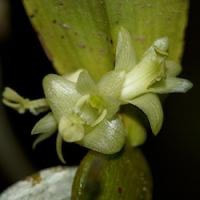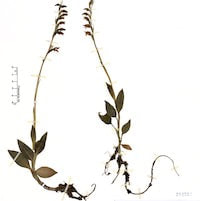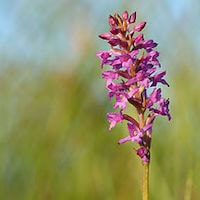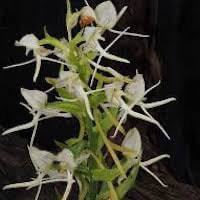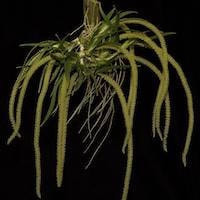WFR11- Women's Fresh 11 - It's herb-itual
|
Native Singaporean Orchid notes: Brassocattleya Humming Ange
Brassocattleya Humming Angel, a hybrid orchid resulting from Brassavola nodosa and Cattleya Angelwalker, plays a key role in the Fresh 11 (Women) perfume workshop, enhancing the team-building experience with its captivating fragrance. This orchid is compact and ideal for indoor growing, boasting large, elegant flowers in nodosa's shape but fuller, in soft hues from off-white to pale pink. Its distinct aroma adds a delightful element to the workshop, fostering camaraderie and creating a refreshing atmosphere for participants.
|
Therapeutic Orchid notes:
|
Dendrobium nobile Lindl. Syn Dendrobium lindleyanum Griff., D. coerulescens Lindl., D. formosanum Rchb. f.
Dendrobium nobile, also called Jinchashihu or Gold Hairpin Dendrobium, is a notable orchid species celebrated for its varied names and pharmacological properties. Growing as an epiphyte in sparse forests, it showcases vibrant flowers and contains Dendroflorin, which aids lung cell proliferation. Sesquiterpenoids like Dendrobine offer mild pain relief and antipyretic effects, with additional compounds like Moscatilin and Ephemeranthol A showing antimutagenic and anti-inflammatory potential. In traditional Chinese medicine, it's valued for stomach health, hydration, and Yin reinforcement, while globally, it's recognized for treating fever and other ailments. |
|
Dendrobium xantholeucum Rchb. f. syn. Flickingeria xantholeuca A. Hawkes; Ephemerantha lonchophylla (Hook.f.) P.F.Hunt & Summerh.
Dendrobium xantholeucum, also known as Jiye Jin Shihu or Sharp Leaf Gold Dendrobium, is a small epiphytic orchid found in Thailand, Malaysia, Indonesia, and southern Taiwan, thriving at elevations up to 1000 meters. It contains compounds like Ephemeranthone, Lonchophylloids A and B, denbinobin, and a phenanthroquinone derivative, which exhibit antioxidant properties and potential for cancer treatment. In traditional Chinese medicine, it is used as shihu, valued for its medicinal history dating back 5000 years and documented in ancient texts like Shen Nong's Bencao Jing. |
|
Goodyera kwangtungensis C.L. Tso
Goodyera kwangtungensis, also called Guangdongbanye Lan or Guangdong Province Spotted Leaf Orchid, is harvested in Guangdong and Guangxi regions for its medicinal properties. Recognized by its spotted leaves, this orchid blooms from May to June. In traditional herbal medicine, the entire plant of Goodyera kwangtungensis is used to support lung health, clear phlegm, and improve respiratory conditions. Its historical use underscores its role in treating lung-related ailments, emphasizing its importance in traditional medicinal practices. |
|
Gymnadenia crassinervis Finet
Gymnadenia crassinervis, known as Duanjushoushen or Palm Ginseng in Chinese, is native to a small region in China, thriving in Rhododendron thickets and rocky slopes at elevations from 2000 to 3800 meters. In traditional Chinese medicine, it belongs to the "palm ginseng" group alongside other species like Gymnadenia conopsea and Coeloglossum viride. These herbs are esteemed for nourishing blood and alleviating conditions such as weak lungs, coughs, and chronic diarrhea. Gymnadenia crassinervis is specifically valued for its robust veins, highlighting its role in traditional medicine for promoting overall health and treating diverse ailments according to Chinese herbal principles. |
|
Habenaria fordii Rolfe
Habenaria fordii, also called Changjukuorui Lan or Xianbanyufeng Hua in Chinese, is an orchid known for its white flowers that bloom from July to August. It is native to Guangdong, Guangxi, and Yunnan in China, preferring damp habitats like forested areas and valleys. In traditional medicine, the roots of Habenaria fordii from Guangxi and Yunnan are used to relieve indigestion in children. This orchid is valued for its medicinal properties, providing a natural remedy for digestive issues according to traditional herbal practices. |
|
Hippeophyllum scortechinii (Hook f.) Schltr.
Hippeophyllum scortechinii, known as Setawar baker perah in Malay, is an epiphytic orchid found in Sumatra, the Malay Peninsula, Java, Borneo, and Sulawesi. It thrives in shady areas near rivers, mainly in Pahang and Perak, Malaysia. In traditional Malay medicine, locals in Kuala Lipis, Pahang, use heated leaves of Hippeophyllum scortechinii to extract juice applied to alleviate earaches. This practice reflects regional knowledge, employing natural remedies to relieve discomfort effectively. |
Other scent note
Scentopia Library Reference ingredient
River Peppermint- Sentosa's plants - Check details at Scentopia's scent library
Download the guided mediation that works best with this Orchid fragrance oil
| women_fresh_essential_oil_orchi_00011.mp3 | |
| File Size: | 114187 kb |
| File Type: | mp3 |

